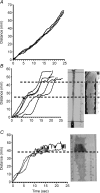Purinergic neuromuscular transmission is selectively attenuated in ulcerated regions of inflamed guinea pig distal colon
- PMID: 20064853
- PMCID: PMC2834943
- DOI: 10.1113/jphysiol.2009.185082
Purinergic neuromuscular transmission is selectively attenuated in ulcerated regions of inflamed guinea pig distal colon
Abstract
This study was undertaken to investigate neuromuscular transmission in regions of the inflamed colon in which motility is disrupted. Propulsive motility was evaluated in segments of control guinea pigs and those treated 6 days previously with trinitrobenzene sulfonic acid. Intracellular recordings were then obtained from circular muscle cells to examine excitatory and inhibitory junction potentials (EJPs and IJPs). In inflamed preparations, propulsion of fecal pellets was temporarily halted or obstructed at sites of mucosal damage, whereas the propulsive motility was linear in control colons. The amplitudes of evoked and spontaneous IJPs were significantly reduced in ulcerated regions of inflamed preparations, but EJPs were comparable to controls. Pharmacological dissection of the IJP revealed that the purinergic component was reduced, while the nitrergic IJP was slightly increased. Furthermore, the reduction in the purinergic IJP in inflamed preparations persisted in the presence of hexamethonium, suggesting that the deficit involved the inhibitory motor neuron and/or smooth muscle. Nerve fibre density was not altered in the circular muscle, and pre-contracted rings of inflamed colon relaxed normally to ATP, suggesting that the deficit involves altered ATP release and/or degradation. The P2Y(1) receptor antagonist MRS2179 slowed propulsive motility indicating that decreased purinergic neuromuscular transmission could contribute to the inflammation-induced motor deficit. We conclude that purinergic inhibitory neuronal input to the circular muscle is selectively reduced in regions of the colon in experimental colitis where the mucosa is damaged, and this is likely to contribute to altered motility in colitis by diminishing downstream relaxation during the peristaltic reflex.
Figures










Similar articles
-
Purinergic neuromuscular transmission in the gastrointestinal tract; functional basis for future clinical and pharmacological studies.Br J Pharmacol. 2014 Oct;171(19):4360-75. doi: 10.1111/bph.12802. Epub 2014 Sep 5. Br J Pharmacol. 2014. PMID: 24910216 Free PMC article. Review.
-
Oxidative stress disrupts purinergic neuromuscular transmission in the inflamed colon.J Physiol. 2013 Aug 1;591(15):3725-37. doi: 10.1113/jphysiol.2013.254136. Epub 2013 Jun 3. J Physiol. 2013. PMID: 23732648 Free PMC article.
-
The relationship between inflammation-induced neuronal excitability and disrupted motor activity in the guinea pig distal colon.Neurogastroenterol Motil. 2011 Jul;23(7):673-e279. doi: 10.1111/j.1365-2982.2011.01702.x. Epub 2011 Mar 23. Neurogastroenterol Motil. 2011. PMID: 21426440
-
Inhibitory neuromuscular transmission mediated by the P2Y1 purinergic receptor in guinea pig small intestine.Am J Physiol Gastrointest Liver Physiol. 2007 Jun;292(6):G1483-9. doi: 10.1152/ajpgi.00450.2006. Epub 2007 Feb 22. Am J Physiol Gastrointest Liver Physiol. 2007. PMID: 17322065
-
Colitis-induced neuroplasticity disrupts motility in the inflamed and post-inflamed colon.J Clin Invest. 2015 Mar 2;125(3):949-55. doi: 10.1172/JCI76306. Epub 2015 Mar 2. J Clin Invest. 2015. PMID: 25729851 Free PMC article. Review.
Cited by
-
Alteration of neuromuscular transmissions in the hamster colon following the resolution of TNBS-induced colitis.J Physiol Sci. 2013 Jul;63(4):241-9. doi: 10.1007/s12576-013-0256-9. Epub 2013 Apr 9. J Physiol Sci. 2013. PMID: 23568479 Free PMC article.
-
Dynamics of inhibitory co-transmission, membrane potential and pacemaker activity determine neuromyogenic function in the rat colon.Pflugers Arch. 2014 Dec;466(12):2305-21. doi: 10.1007/s00424-014-1500-8. Pflugers Arch. 2014. PMID: 24658973
-
Diminished enteric neuromuscular transmission in the distal colon following experimental spinal cord injury.Exp Neurol. 2020 Sep;331:113377. doi: 10.1016/j.expneurol.2020.113377. Epub 2020 Jun 8. Exp Neurol. 2020. PMID: 32526238 Free PMC article.
-
Neurotransmitters responsible for purinergic motor neurotransmission and regulation of GI motility.Auton Neurosci. 2021 Sep;234:102829. doi: 10.1016/j.autneu.2021.102829. Epub 2021 Jun 2. Auton Neurosci. 2021. PMID: 34146957 Free PMC article.
-
Purinergic neuromuscular transmission in the gastrointestinal tract; functional basis for future clinical and pharmacological studies.Br J Pharmacol. 2014 Oct;171(19):4360-75. doi: 10.1111/bph.12802. Epub 2014 Sep 5. Br J Pharmacol. 2014. PMID: 24910216 Free PMC article. Review.
References
-
- Chen Z, Suntres Z, Palmer J, Guzman J, Javed A, Xue J, Yu JG, Cooke H, Awad H, Hassanain HH, Cardounel AJ, Christofi FL. Cyclic AMP signalling contributes to neural plasticity and hyperexcitability in AH sensory neurons following intestinal Trichinella spiralis-induced inflammation. Int J Parasitol. 2007;37:743–761. - PubMed
-
- Coulie B, Camilleri M, Bharucha AE, Sandborn WJ, Burton D. Colonic motility in chronic ulcerative proctosigmoiditis and the effects of nicotine on colonic motility in patients and healthy subjects. Aliment Pharmacol Ther. 2001;15:653–663. - PubMed
Publication types
MeSH terms
Grants and funding
LinkOut - more resources
Full Text Sources
Medical

